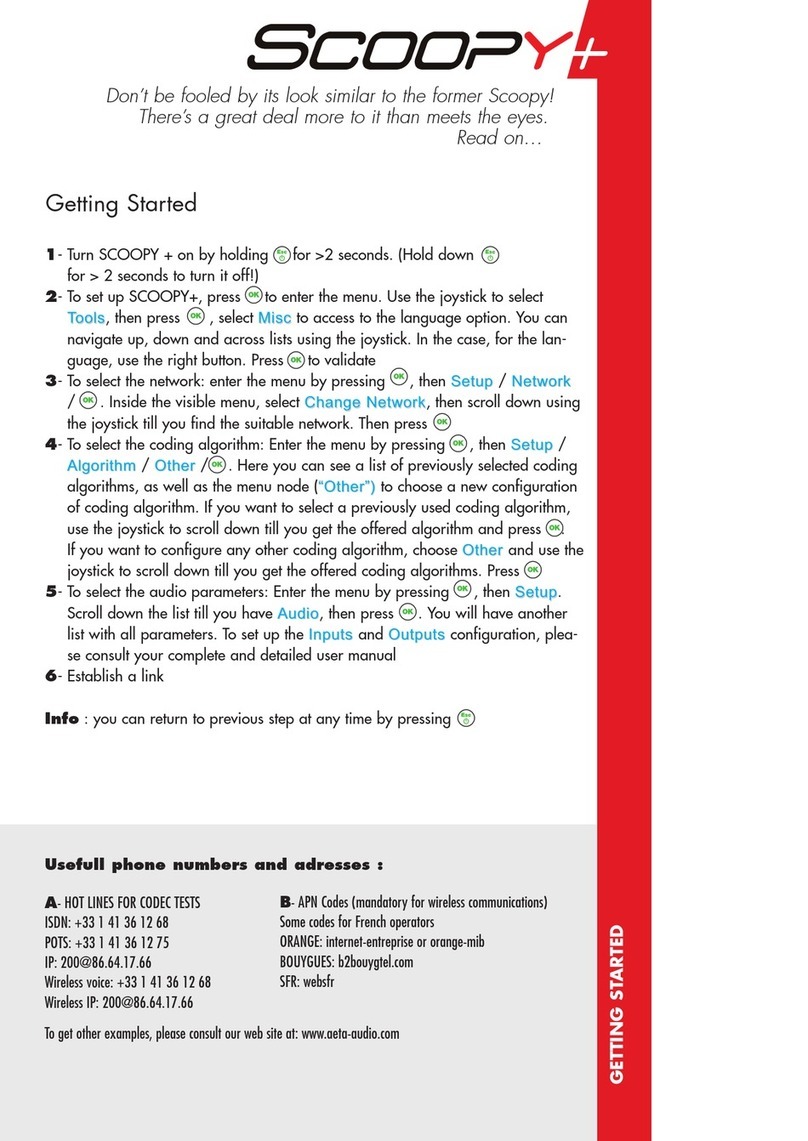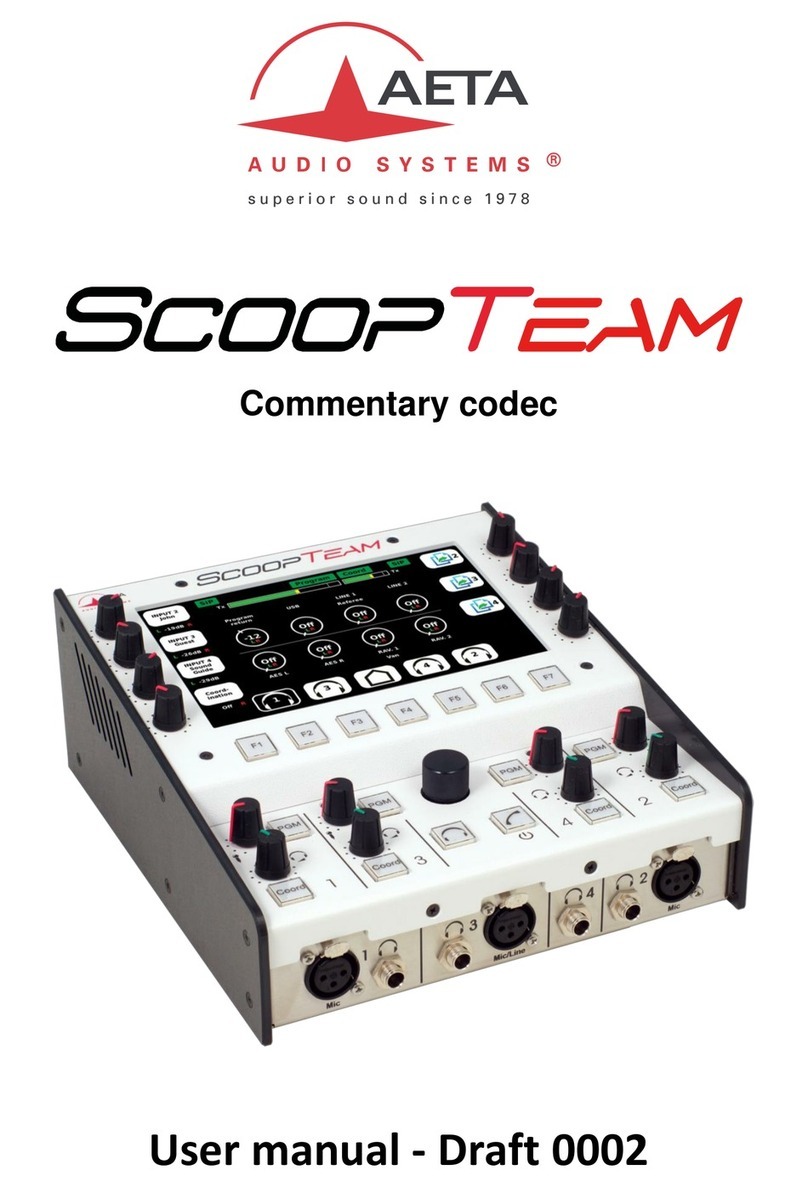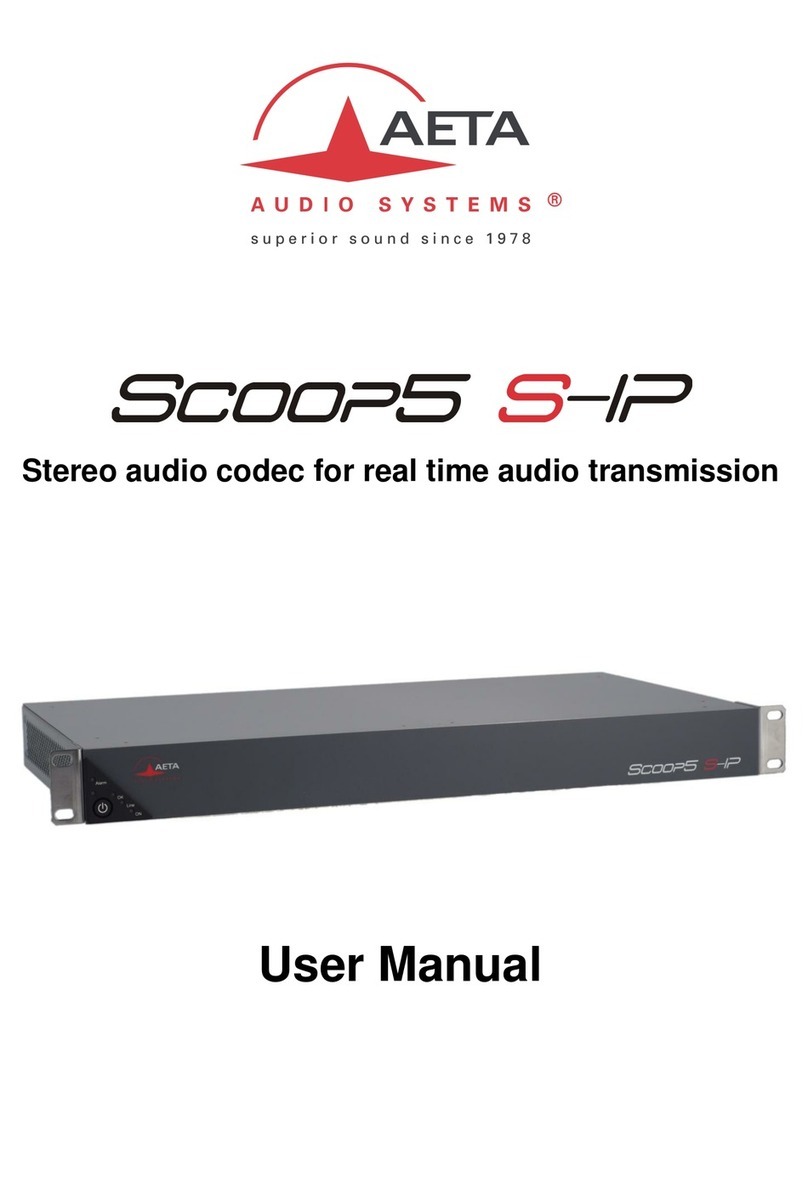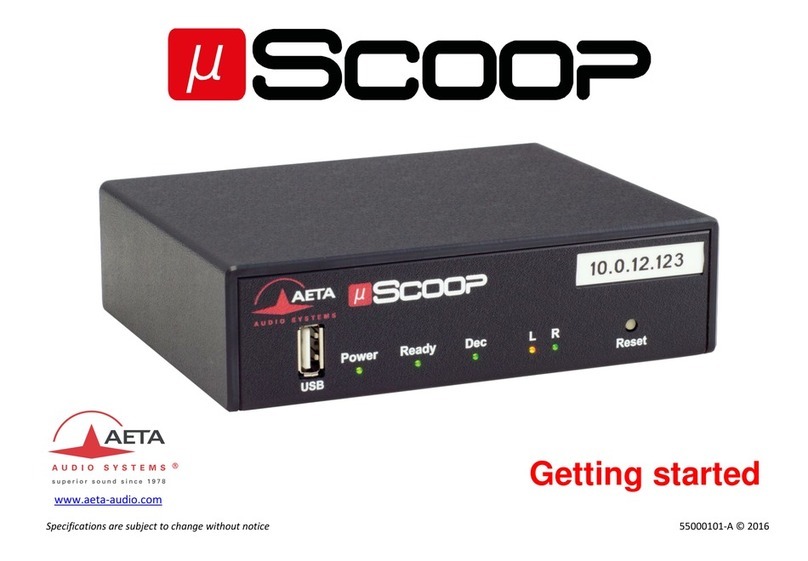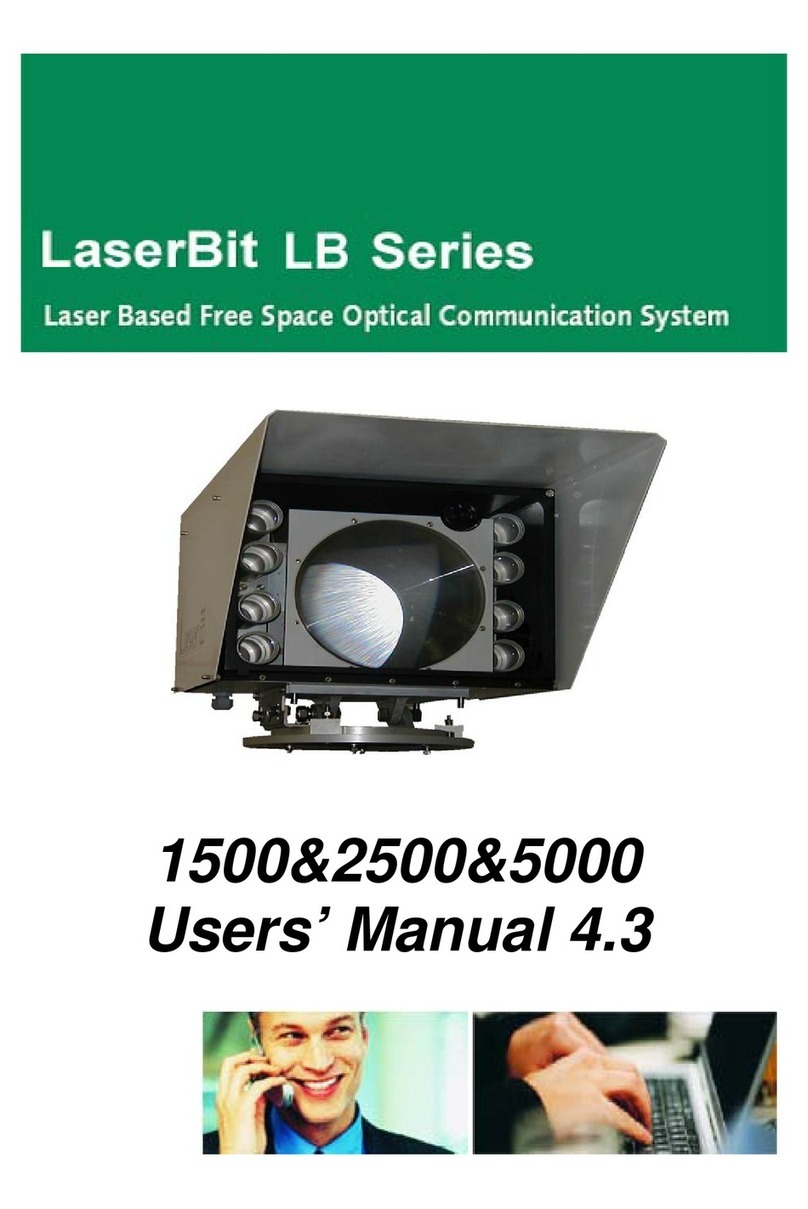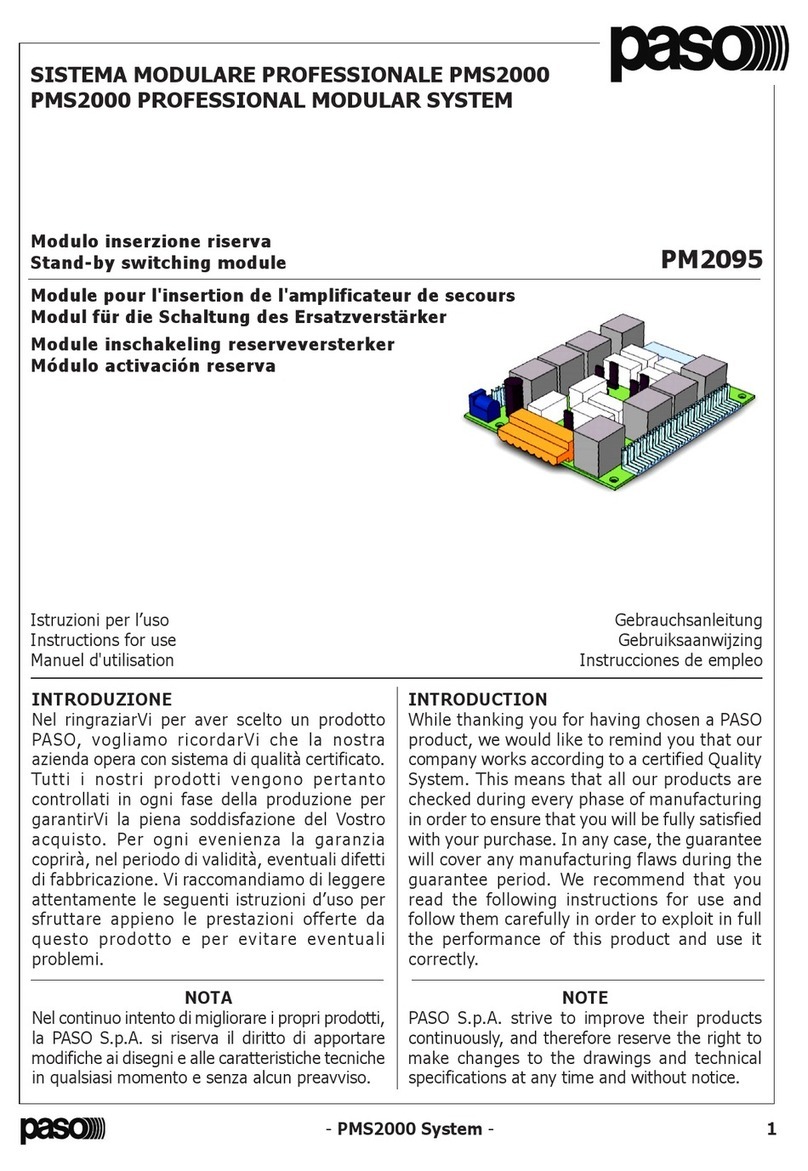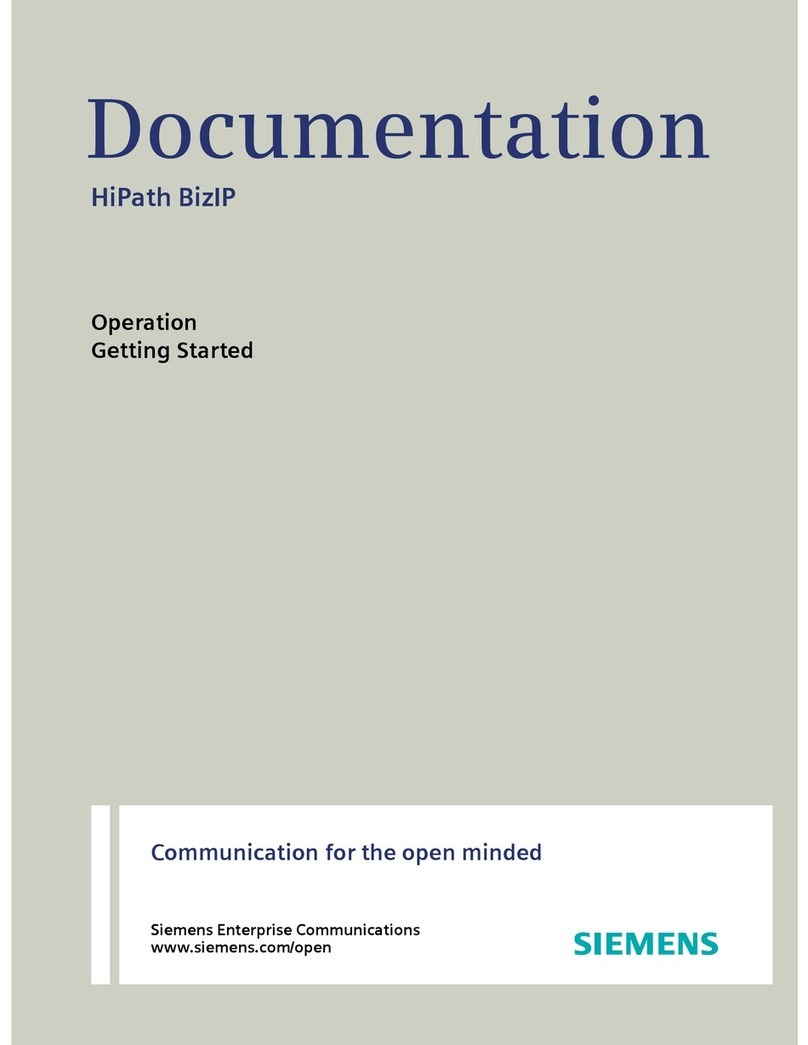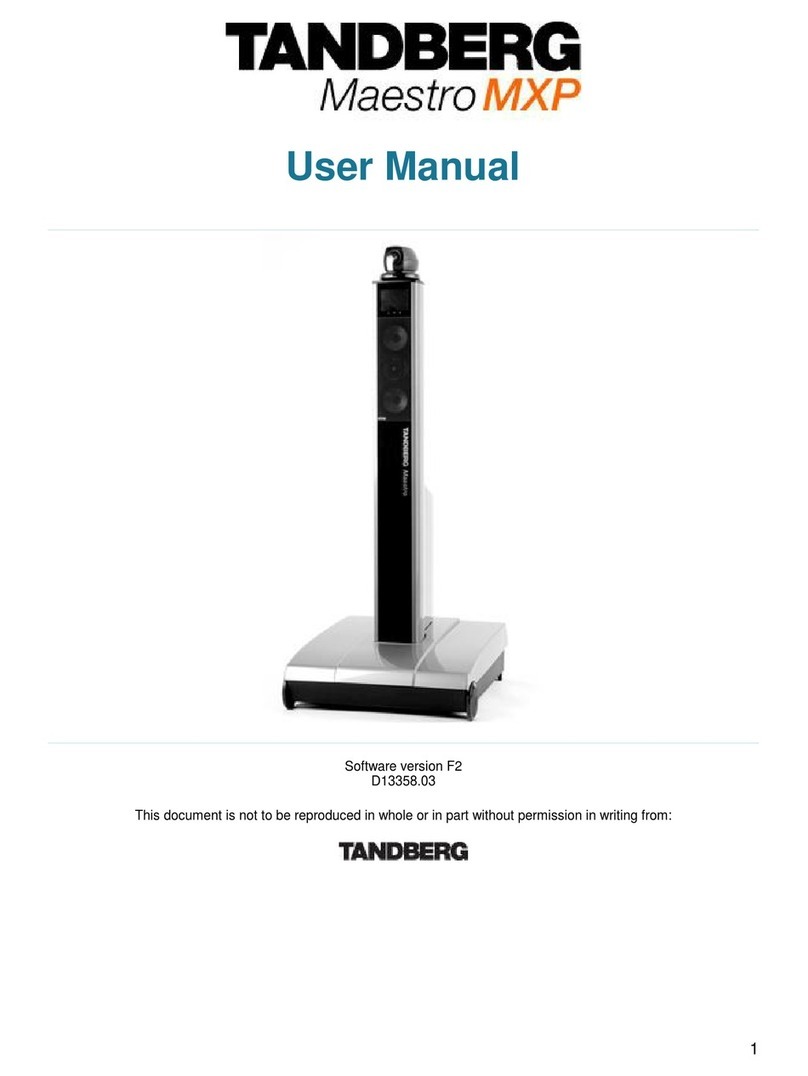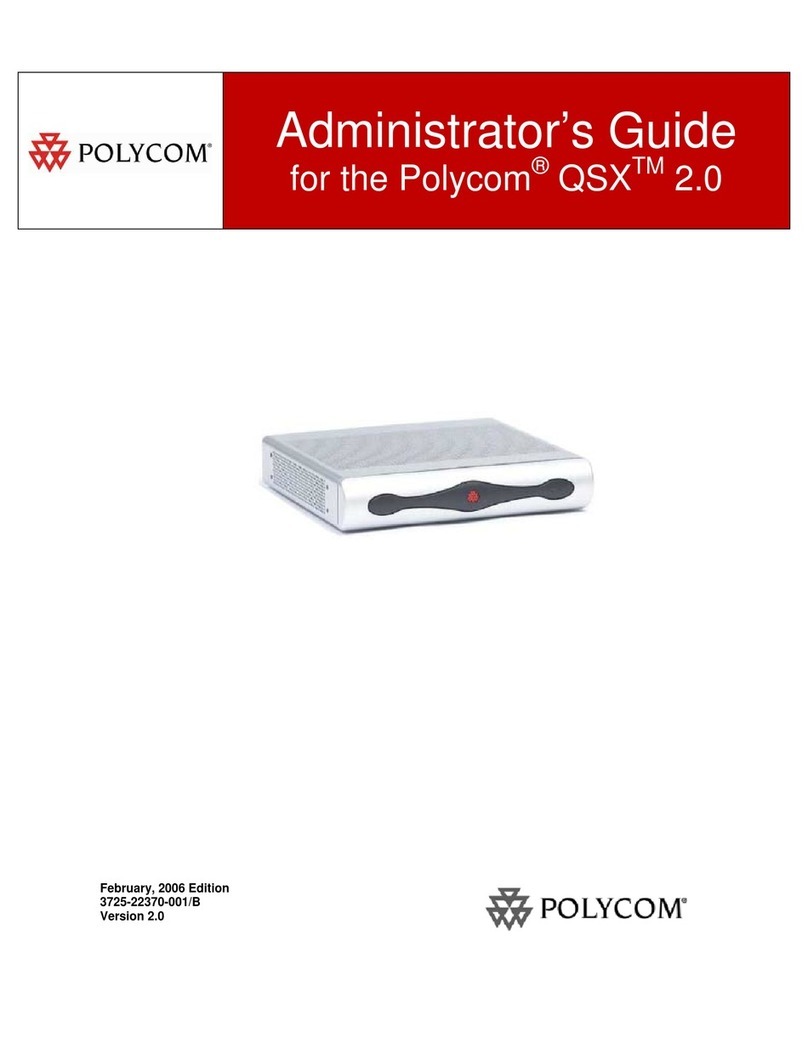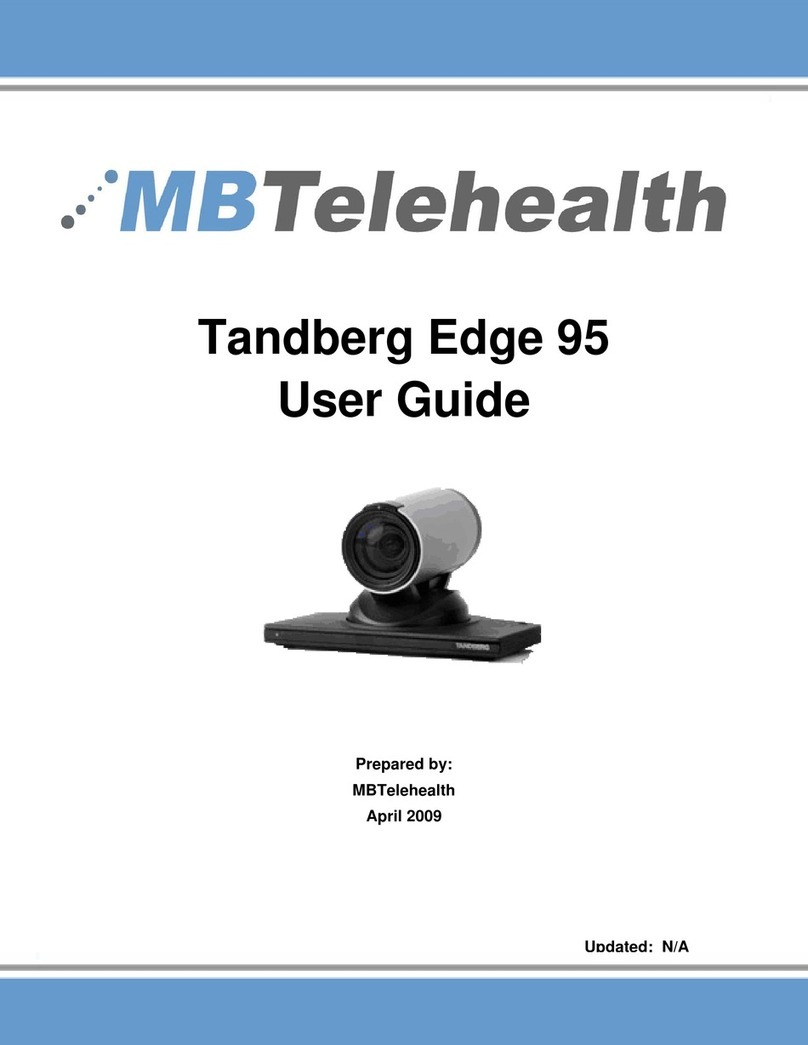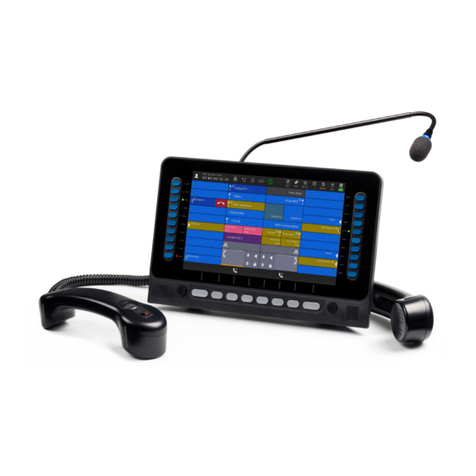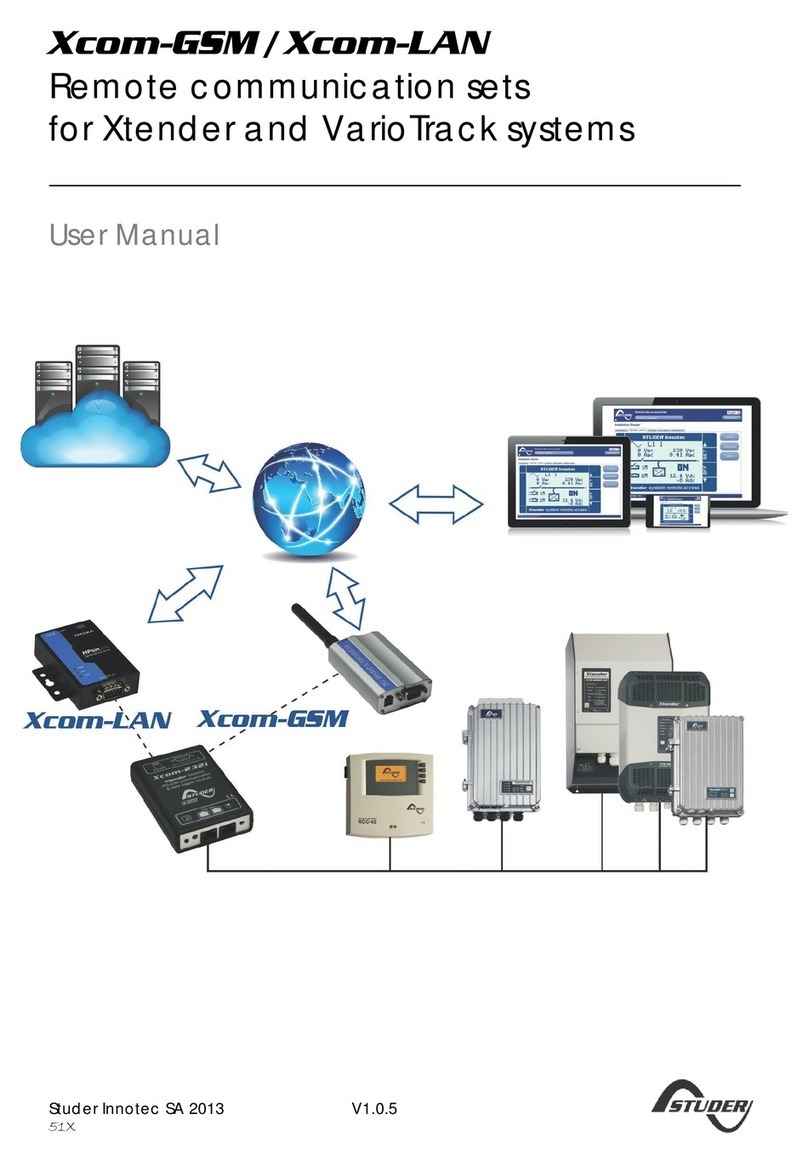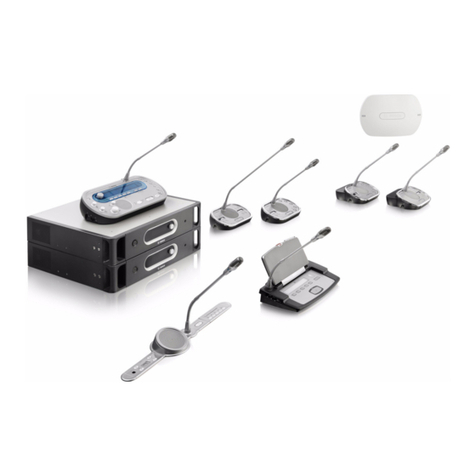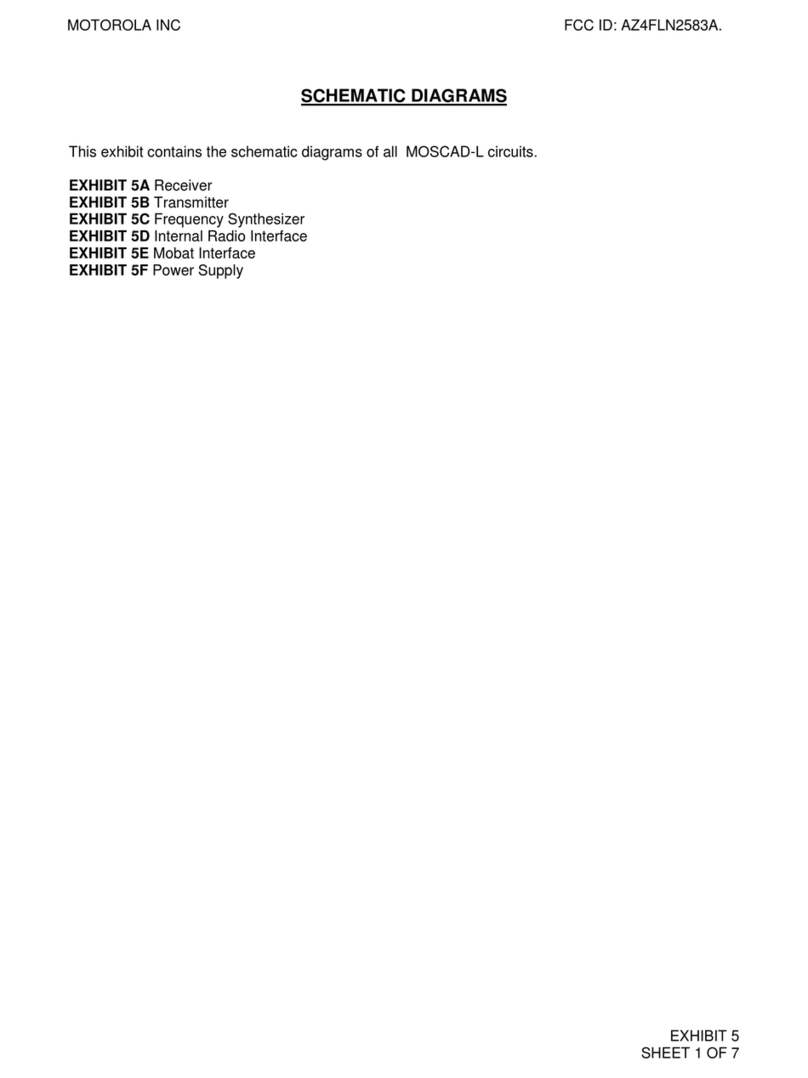Aeta Audio Systems Scoop 6 User manual

Scoop 6
Stereo audio codec for real time audio transmission
User Manual


Scoop6 - User Manual
Table of contents
1. Presentation –Getting started.......................................................................... 1
1.1. Install and connect Scoop 6.........................................................................................3
1.2. Audio settings..............................................................................................................3
1.3. Select and set up network to be used: wired networks.................................................3
1.4. Select and set up network to be used: mobile networks...............................................4
2. Functions............................................................................................................ 6
2.1. Transmission interfaces...............................................................................................7
2.2. Audio encoding and decoding....................................................................................12
2.3. Audio interfaces.........................................................................................................16
2.4. Auxiliary functions......................................................................................................17
2.5. Supervision and control interface...............................................................................19
3. Operation...........................................................................................................22
3.1. General principles –Control means...........................................................................22
3.2. Physical description of the equipment........................................................................23
3.3. Installation and set up................................................................................................27
3.4. Initial setup of the Ethernet interface..........................................................................28
3.5. Managing links...........................................................................................................30
3.6. First level maintenance..............................................................................................32
4. Detailed operating mode –User interface ......................................................33
4.1. Starting up .................................................................................................................33
4.2. Navigation principles..................................................................................................33
4.3. Menus presentation ...................................................................................................34
5. Operating mode –Embedded HTML pages....................................................40
5.1. Accessing the Scoop 6 html pages............................................................................40
5.2. Principles of operation with html pages......................................................................42
5.3. “STATUS” tab ..............................................................................................................43
5.4. “CONNECTIONS” tab ....................................................................................................44
5.5. “PROFILES” tab ...........................................................................................................46
5.6. “NETWORK” tab ...........................................................................................................48
5.7. “AUDIO” tab.................................................................................................................51
5.8. “CODING” tab ..............................................................................................................52
5.9. “MISC” tab ..................................................................................................................53
5.10. “MAINTENANCE” tab...................................................................................................54
5.11. “ALARM” tab..............................................................................................................61
6. Technical characteristics.................................................................................62
6.1. Characteristics of interfaces.......................................................................................62
6.2. Audio performance.....................................................................................................66
6.3. Network protocols and ports.......................................................................................68
6.4. Power supply.............................................................................................................70

Scoop6 - User Manual
6.5. Dimensions and weight..............................................................................................70
6.6. Environmental characteristics....................................................................................70
6.7. Options......................................................................................................................71
6.8. Accessories and related products..............................................................................72
7. Annexes ............................................................................................................ 73
7.1. Overview of the SIP protocol .....................................................................................73
7.2. Some methods to deal with NAT routers and firewalls...............................................76
7.3. Notice regarding open source code...........................................................................81
8. Index.................................................................................................................. 82

Scoop6 - User Manual
1
1. Presentation –Getting started
The Scoop 6 codec allows the bi-directional transmission of one or two audio signals with bit rate
reduction, over various transmission media: IP protocol networks, mobile networks, AES 67 networks or
even WIFI networks by using an external USB key.
The standard version of the codec includes an Ethernet interface for IP transmission. The unit can be
complemented with many options providing additional network interfaces, coding algorithms, etc.
In IP mode, the codec features the same ease of operation thanks to the use of the SIP and SDP
protocols.
For IP transmission with SIP, the unit can be operated in a “double codec” mode. It is then equivalent to
two independent mono codecs, both running over the IP interface.
This chapter gives basic instructions for a quick start. It obviously does not provide all the information
for full control. For comprehensive information one can refer to the rest of this manual:
Chapter 2 describes all the functions and features of the Scoop 6 (but not necessarily with all
the operating modes)
Chapter 3 gives a physical description of the unit, shows its setting up and operation
principles.
Chapter 4 details menus and operating modes.
Chapter 5 deals with using the html server embedded in Scoop 6
Chapter 6 provides all the technical characteristics of the Scoop 6
The annexes bring miscellaneous additional information, including an index you can use to look
for a given information topic.
The following table shows the main features of the product. Functions marked with in this table are
available as options.
Note: this document is relevant for units with firmware version 1.00.

2
Scoop6 - User Manual
Characteristics
Optional
Transmission interfaces
Ethernet/IP transmission interface
Ethernet Interfaces, 10BaseT/100BaseT & 1000BaseT; TCP/IP, UDP/IP, RTP protocols
Audio transmission (AoIP) in unicast mode: SIP signalling protocol, SDP, RTP streaming
Double AoIP/SIP codec operation mode
Audio transmission in multicast mode: RTP streaming
Net bit rate 12 to 256 kbit/s (depending on coding algorithm, linear coding excluded)
Mobile network access
Integrated 2G/3G/3G+/LTE/5G network access module, 2 antenna sockets
Voice mode: standard telephone or “HD Voice” (7 kHz with AMR-WB)
Packet data mode: IP protocol, SIP signalling, SDP, RTP streaming, net bit rate 12 to 256 kbit/s
(depending on coding algorithm)
External 3G/LTE module connection via USB socket (data mode only)
Audio coding algorithms
(audio modes)
G711
GSM, AMR (mobile telephone)
AMR-WB / G722.2 (mobile “HD Voice”)
G722
MPEG Audio Layer II
MPEG AAC-LC , HE-AAC, HE-AAC v2, AAC-LD, AAC-ELD
OPUS
Linear L16, L20, L24
Mono
Mono
Mono
Mono
Mono, Stereo, Dual mono, Joint stereo
Mono, Stereo
Mono, Stereo
Mono, Stereo
Audio interfaces
Two analog inputs and two analog outputs with adjustable gain
Digital input and output, AES/EBU format
Level display for encoder inputs and decoder outputs
Stereo headphone socket for monitoring, switchable send/receive
AES 67 DANTE or RAVENNA
Auxiliary functions (available depending on transmission interface)
Relay transmission: 2 isolated inputs and 2 isolated outputs, 6 non isolated inputs and outputs
SMS reception via the optional mobile access
Control and supervision
Rotary encoder and graphic display on front panel
Programmable set-up/dial memories
Ethernet/IP remote control, Embedded html server
Isolated control and status loops
Secondary Ethernet interface for remote control
Table 1 –Main features of the Scoop6

Scoop6 - User Manual
3
1.1. Install and connect Scoop 6
Plug on a power source. To start it, press the key (bottom left corner on the front panel) for
at least 3 seconds.
Connect the necessary audio interfaces. (Analog or digital via XLR)
Connect Scoop 6 on the transmission network. (Ethernet, mobile,…)
Using the Scoop 6 menus: key to activate the carrousel menu, select ⚙with the rotary
encoder and press key (pressing the rotary encoder) to menu access. Use the rotary
encoder to select a sub-menu or a parameter, enter or validate with the key. to jump
back up to the previous menu level, until getting back to the home screen (with level display).
1.2. Audio settings
With factory settings, the active inputs are the analog ones, and the clipping level is set at
+16 dBu for both inputs and outputs.
Enter the menus using , then ⚙and finally select Audio. Perform necessary settings.
(Analog, digital, AES67, line in/out)
1.3. Select and set up network to be used: wired networks
For a link over a public IP network via an access router with NAT1, it is recommended to use
a STUN server.
The address of a STUN server can be set in the Scoop 6 html pages using the tab: Network / AoIP
Parameters / STUN, enter the address of a STUN server (we propose our server stun.aeta-
audio.com, look also the support pages on our web site www.aeta-audio.com). Enable or disable
STUN.
More details: see chapter 5.
To choose the network: in the main menu, select IP / IP interface then the desired network,
validate with .
Check that the Ethernet interface is active (indicator on the display and/or LED on the Ethernet
port on the rear panel), and that the IP address has been assigned: Ethernet / IP Address menu.
Return to the main menu.
The default setting uses a DHCP server to obtain an IP address, and is adequate in most cases.
In other cases, see details on 3.4.1.
Enter the remote number to call (numeric IP address, or SIP URI if a SIP server is used) in the
HTML page via the Connections / Connection State menu, then click on Dial.
Hanging up will also be done via the HTML page by clicking on Release.
When using a SIP server, some data must be entered beforehand using the IP menu; for more
details, refer to 7.2. Similarly, some preliminary settings may have to be done for the “Direct
RTP” mode (without the SIP protocol) or the multicast mode.
1Network Address Translation, which is performed in most cases by the access router.

4
Scoop6 - User Manual
1.4. Select and set up network to be used: mobile networks
To set links over a mobile network, an antenna connection is required, and you must have a SIM
card with a subscription suitable for the use. Specifically, for an IP mode transmission the subscription
must include access to data transmission, and RTP audio streams must be allowed.
1.4.1. Set up a (mobile) IP link
For a link over a public IP network via an access router with NAT1, it is recommended to use
a STUN server.
The address of a STUN server can be set in the Scoop 6 html pages using the tab: Network / AoIP
Parameters / STUN, enter the address of a STUN server (we propose our server stun.aeta-
audio.com, look also the support pages on our web site www.aeta-audio.com). Enable or disable
STUN.
More details: see chapter 5.
While the unit is switched off, insert the SIM card into the drawer on the front side of the
Scoop 6.
Switch on the Scoop 6 (depress a few seconds).
Select the network: IP menu then IP Interface, then select Mobile, validate with .
Activate mobile data in the Mobile / Mobile data (On) menu, confirm with .
Configure the PIN code of the SIM card beforehand via the HTML page using an Ethernet
network. Network / Mobile parameters Menu.
Check that the Mobile interface is active (indicator on the display).
Enter the remote number to call (numeric IP address, or SIP URI if a SIP server is used) in the
HTML page via the Connections / Connection status Menu, then click on Dial.
Hanging up will also be done via the HTML page by clicking on Release.
Note: the sequence is much simpler for further calls as long as you keep the same SIM card, because
the network related settings are kept memorized even if the unit is switched off; so you don’t need to
make these settings again (IP Data mode, APN, data activation...). It is even possible to memorize
the PIN code: check the box in Setup / Network / Mobile Parameters /PIN Save.
1Network Address Translation, which is performed in most cases by the access router.

Scoop6 - User Manual
5
1.4.2. Set up a link in voice mode
This mode allows communicating with any telephone terminal through the regular telephone service. It
also allows to benefit from the 7 kHz wide band service known as “HD Voice” whenever the remote
terminal is compatible and the network supports the service.
•In the carousel menu, key . Select HD.
• Then, return to the main menu then select Mobile / Mobile Network. If necessary you can set a
priority between 2G, 3G, 4G and 5G networks. The normal choice is Auto.
• Enter the remote number to call (numeric IP address, or SIP URI if a SIP server is used) in the HTML
page via the Connections / Connection status Menu, then click on Dial.
It is also possible to select the call history via the carousel menu, key . Select / Call List.
• Hanging up will also be done via the HTML page by clicking on Release.

6
Scoop6 - User Manual
2. Functions
Reminder: this chapter details the functions and capability of the Scoop 6, but not necessarily
describes the detailed operating modes, developed in other chapters.
The following block diagram shows the basic functions of the equipment.
Figure 1 –Functional diagram of the equipment
The audio signals to be transmitted are converted (when needed) to digital format, then the encoding
function reduces the bit rate, using a selectable algorithm; the resulting bit flow is sent to one of the
available transmission interfaces: Ethernet interface, mobile network...
The transmission interface functional block also extracts compressed data coming from the network and
sends them to a decoding block that reproduces uncompressed audio data. Last, the audio signals are
output to both digital and analogue outputs.
Monitoring the audio interfaces is possible thanks to a headphone and level meters for the
inputs/outputs.
In addition to the main task of transmitting an audio programme, the Scoop 6 can also transmit auxiliary
information, usually by embedding them inside the transmitted audio streams.
Supervision and controlling the unit is performed using various remote control interfaces, and of course
by means of the displays and controls on the front panel.

Scoop6 - User Manual
7
2.1. Transmission interfaces
The Scoop 6 features in all versions an Ethernet interface for IP protocol networks. A Mobile interface
can also be added with an option.
2.1.1. Ethernet/IP interfaces
The IP interfaces is a 10BaseT/100BaseT and a 1000BaseT Ethernet interface allowing transmission of
the audio programmes in a wide range of possible bit rates. The audio stream is always transported
under the RTP/UDP protocol.
Available audio coding algorithms
The audio coding algorithm can be selected depending on the required quality and the available
network bandwidth. The following algorithms are currently available:
Codec
Bit rate
(coding)
Bit rate
(total)1
Audio
bandwidth
Typical use, main features
G711
64 kbit/s
86 kbit/s
3 kHz
Voice, telephony
Compatible with IP phones
G722
64 kbit/s
86 kbit/s
7 kHz
High quality speech.
Compatible with some IP phones.
MPEG Layer II
64 to 256
kbit/s
73 to 275
kbit/s
Up to
20 kHz
Highest quality, suitable for speech and music
MPEG AAC-LC
16 to 256
kbit/s
30 to 277
kbit/s
Up to
20 kHz
Low bit rate, suitable for speech and music
MPEG AAC-LD
16 to 256
kbit/s
30 to 277
kbit/s
Up to
20 kHz
Low bit rate, suitable for speech and music
MPEG AAC-ELD
16 to 256
kbit/s
30 to 277
kbit/s
Up to
20 kHz
Low bit rate, suitable for speech and music
MPEG HE-AAC and
HE-AAC v2
16 to 128
kbit/s
23 to 139
kbit/s
Up to
20 kHz
Very low bit rate, suitable for speech and music
OPUS
12 to 256
kbit/s
28 to 272
kbit/s
Up to
20 kHz
Low bit rate and low latency, suitable for
speech and music
Linear L16/L20/L24
512 to 2304
kbit/s
592 to 2384
kbit/s
Up to
20 kHz
Best quality, very low latency
Table 2 –Overview of algorithms available in IP mode
Chapter 2.2 "Audio coding and decoding" describes in more detail the characteristics of these various
codings.
1Informative value; higher than the “net” encoded audio bit rate because of the protocol overhead

8
Scoop6 - User Manual
AoIP unicast mode
The most classical transmission mode is unicast: audio connection with one remote device, generally
bidirectional. This mode can be used on all types of networks links, LAN or WAN, including links via
Internet. Links can be set up in two ways:
“Peer to peer” connection between two compatible units using a SIP protocol
Use of a SIP proxy server to set up the link, or a SIP PBX
Direct "peer to peer" connection without the SIP protocol, in a so-called "direct RTP" mode.
This mode can be used to interoperate with devices without SIP support, or to bypass any
network blockages specifically affecting the SIP protocol.
SIP and SDP protocols
The SIP protocol is a signalling protocol, used for IP connections, which allows the Scoop 6 to
interoperate with IP phones and other SIP compatible audio codecs. Details about the SIP protocols can
be found in the annex (refer to 8.3, Overview of the SIP protocol).
One significant advantage is the inclusion of SDP, a protocol which allows the connecting devices to
automatically negotiate and agree on the coding profile to use. Thanks to this system, it is not necessary
to set the units in the same way before setting up a connection. Moreover, the calling party needs not
know how the remote unit is configured before initiating a link.
Note: the SIP protocol does not mandatorily imply the use of a server. Codecs can set up point-to-
point links using this protocol, and benefit from some its advantages.
Conversely, for the “Direct RTP” mode, which includes no signalling, it is necessary to configure
beforehand in the same way the two units to be connected.
Double SIP codec
This operation mode is available as an option.
In the unicast mode with SIP, the Scoop 6 can be used as two independent mono codecs. Each of these
is then a mono SIP codec that can set an audio link in two ways:
Direct “peer to peer”connection with a compatible remote unit.
Use of a SIP proxy server to set up the link, or a SIP PBX. In such use case, each codec has got its
own registration.
The available audio coding algorithms are a subset of those of the “standard” mode (single codec): see “
Table 4 –Available coding in double AoIP codec mode”.
Double Streaming
Audio transmission over IP (AoIP) is sometimes subject to data loss which can cause noise or dropouts in
the audio signal. The AETA "Double Streaming" system is an effective means of considerably reinforcing
the robustness of an AoIP transmission to the SIP protocol, thanks to a redundant link which makes it
possible to compensate for losses on the main link.
Chapter 8.1 "Using the "Double Streaming" system describes this mode in detail.
Dual Streaming requires the use of the SIP protocol and cannot be used when the Scoop 6 is operated in
dual SIP codec mode.

Scoop6 - User Manual
9
Packet duplication
Scoop 6 also proposes an RTP transmission mode with enhanced reliability, using packet replication.
When enabling this mode, every packet is transmitted twice; with such system a lost packet has no
effect since the receiver still gets the other copy of the packet. In this way, stable links can be obtained
even with a high packet loss rate. Of course, as a disadvantage the bit rate is double; you must make
sure this stays compatible with the transmission medium.
IP multicast mode
The multicast mode allows an encoder device to transmit an audio programme to several decoders by
sending a single encoded stream to a multicast group address. The link is unidirectional by nature. This
mode can be used on a local area network, and on larger private networks that can manage the
multicast mode. On the other hand, Internet cannot support this routing mode.
In this mode, the Scoop 6 uses the RTP protocol to manage the audio stream, like in the unicast mode,
but the SIP protocol is not applicable here; instead a proprietary signalling system is used. As the link is
unidirectional, the unit has to be set either as a “sender” in order to encode and transmit the audio
stream to the selected group address, or as a “receiver” to receive and decode such stream coming from
a “sender” device.
The audio coding algorithm can be selected with just the same capability as for the unicast mode
described above.
Factory SIP account
AETA has set up a public SIP server, dedicated to "broadcast" audio over IP applications. Our customers
can obtain accounts in order to register their audio codecs on this server.
In addition, each Scoop 6 has a "factory" SIP account on this server. This account is permanently and
definitively associated with the unit, and it is possible at any time to recall its settings to save the Scoop
6 on the server. However, you can also configure another account on any other SIP server.
A second "factory" SIP account is also installed in the device:
• This account can be used to implement "Double Streaming" (see 8.1, Using the "Double Streaming"
system).
• If the "Double SIP codec" is used, this account can be assigned to the second SIP codec.
Remote control via IP
In addition, the Ethernet interface can be used for configuring or remote controlling the unit, with two
control methods:
Scoop 6 provides html pages which allow getting complete control over the unit using a web
browser, via port 80 (default port for http protocol).
The supervision software Scoop Manager from AETA can remote control the Scoop 6 via a
TCP/IP connection on port 7001.
TCP port 6000 can be used for “command line”control, suitable for other codec supervision
software such as TeleScoop, Codec Live, MDC.Net, etc.

10
Scoop6 - User Manual
2.1.2. Mobile network access
Units equipped with the “HD-4G”option include an integrated module for access to mobile networks,
and a holder for a SIM card.
Depending on the version the accessible networks are 2G (GSM, EDGE), 3G (UMTS), 3G+ (HSDPA,
HSUPA, HPA…), and 4G/LTE. An “HD-5G Mobile” option is also available and add a 5G Network to the
product.
For the operation, at least one multiband antenna (to be selected for compliance with the mobile
network characteristics) must be connected on Scoop 6. An antenna “diversity” feature gives an
opportunity to improve the stability when the radio reception quality is poor, by connecting a second
antenna.
Lastly, Scoop 6 can display the received SMS messages.
Mobile voice mode –HD Voice
The integrated module allows to use the mobile phone service, for communicating with other mobile
terminals. The quality is in such case that of mobile connections, with a 300-3400 Hz bandwidth and
coding such as GSM, EFR, AMR...
Now many mobile networks also propose “HD Voice”, an extension of this mobile telephone service.
With this new capability, compatible terminals implement the AMR-WB coding algorithm (standardised
as G722.2 by the ITU-T) and provide speech transmission with a 50-7000 Hz bandwidth and a quality
very similar to the well-known G722. Automatic fallback to the standard coding takes place if the
network does not support the service or one of the terminals does not feature this capability.
No special subscription, other than to the regular telephone service, is needed, but for most operators
only the 3G/3G+ base stations support the service.
This sometimes makes people believe that HD Voice is related to the mobile IP service, but this is
definitely not the case.
More and more mobile phones now support this service, especially (but not only, and not all)
smartphones. All AETA codecs with “HD-4G” mobile network option support HD Voice, namely:
Scoop 4+ in “wireless” version
Scoopy+ HD (except old units, in doubt consult us)
ScoopFone HD, ScoopFone HD-R.
Scoop 5 and Scoopy+ with the HD-4G option
ScoopFone 4G and ScoopFone 4G-R
ScoopFone 5G
Scoop 6 with the HD-xG option
ScoopTeam with de HD-xG option
ScoopyFlex with the HD-xG option

Scoop6 - User Manual
11
Mobile IP mode
The other service available with mobile access is the data packet transmission mode, abbreviated as
“PS” (for Packet Switched), with IP protocol.
This mode brings similar capabilities as a wired IP connection via the Ethernet interface, as described
above in 2.1.1, with some distinctive characteristics:
This requires a subscription including access to the data service, with conditions compliant with
the application. Among other requirements, an APN (Access Point Name) must be provided
that allows this type of media stream. Some operators provide such allowance in a “VoIP”
option.
The available bit rate depends on various factors; first the network technology
(2G/3G/3G+/4G/5G), but also the traffic level in the radio cell, the operator’s network capacity,
possibly the type of subscription. This may bring on restrictions for the usable compression
algorithms.
The multicast mode is not available on mobile networks.
Setting a link implies first activating the data connection, before actually initiating an audio
stream transmission link.
2.1.3. Managing calls
The audio transmission implies a link/session setup phase.
One of the transmission interfaces is selected as the default interface on the Scoop 6.
A call towards a remote unit, initiated by the user of the Scoop 6, is implicitly sent through this default
interface.
On the other hand, an incoming call on any interface (regardless of the default interface) can be
processed and the link established, under conditions described in 4.5.5, “Call Reception”
If the call comes on an interface other than the default interface, the codec first switches to the suitable
interface, and then processes the incoming call. When the link is released, it will come back to its
previous state (and default interface).
The detailed procedure for establishing a connection is described in 4.5, "Establishing a link".

12
Scoop6 - User Manual
2.2. Audio encoding and decoding
Scoop 6 features a wide range of coding algorithms. Their availability depends on the transmission
network used, and on the single/double codec mode that is used. Besides, the MPEG family algorithms
feature a large configuration flexibility.
2.2.1. Single codec
In this mode, the selected network interface (Ethernet/IP) is used to set a link with a single remote
device. The table below synthetically describes the capabilities with the various transmission media:
Codec
Audio
Channels
16 24 32 48
Net bit rate
(kbit/s)
Ethernet Mobile IP HD Voice
G711 Mono 64
G SM, AMR Mono -
AMR-WB Mono -
G722 Mono 64
MPEG L2 M/S 64
MPEG L2 M/S 128
MPEG L2 M/S 192
MPEG L2 Stereo 256
AAC-LC M/S 16 => 56
AAC-LC M/S 64
AAC-LC M/S 96
AAC-LC M/S 128
AAC-LC M/S 192
AAC-LC Stereo 256
HE-AAC M/S 16 => 56
HE-AAC M/S 64
HE-AAC Stereo 96
HE-AAC Stereo 128
HE-AAC V2 Stereo 16 => 56
HE-AAC V2 Stereo 64
OPUS M/S 12 => 256
Linear L16 Mono 512 / 768
Linear L16 Stereo 1024 / 1536
Linear L20 Mono 640 / 960
Linear L20 Stereo 1280 / 1920
Linear L24 Mono 768 / 1152
Linear L24 Stereo 1536 / 2304
AAC-LD M/S 16 => 56
AAC-LD M/S 64
AAC-LD M/S 96
AAC-LD M/S 128
AAC-LD M/S 192
AAC-LD Stereo 256
AAC-ELD M/S 16 => 56
AAC-ELD M/S 64
AAC-ELD M/S 96
AAC-ELD M/S 128
AAC-ELD M/S 192
AAC-ELD Stereo 256
3kHz 7kHZ 20kHz
Frequency
Table 3 –Available coding depending on network

Scoop6 - User Manual
13
2.2.2. Double AoIP codec
This mode is available for the transmission over an IP access (Ethernet or possibly a mobile network) and
with the SIP protocol.
In this mode, two AoIP links can be set simultaneously, possibly with two separate remote devices.
Either link is a mono link. The table below shows the capabilities for each link:
Codec
Frequency
8 16 48
Net bit rate
(kbit/s)
G711
G722
MPEG L2
MPEG L2
AAC-LC
AAC-LC
AAC-LD
AAC-LD
AAC-ELD
AAC-ELD
HE-AAC
HE-AAC
OPUS
Table 4 –Available coding in double AoIP codec mode
2.2.3. Details about the coding algorithms
The following chapters bring some precisions about the important features of the various algorithms
and protocols available.
G711 coding
Application: telephony, coordination. Low latency.
G711 is the standard coding used for voice transmission on public telephone networks, and features 300
to 3400 Hz audio bandwidth. This algorithm is typically used for links over IP networks with IP
telephones or VoIP gateways.
G711 is available only for IP (single or double codec).

14
Scoop6 - User Manual
Mobile telephony coding: GSM , AMR
Application: telephony, mobile coordination. Moderate latency.
These algorithms are exclusively used for speech transmission over mobile telephone networks, with a
300 to 3400 Hz audio bandwidth. Gateways perform, whenever needed, transcoding in order to
interface with fixed IP networks.
Mobile HD Voice coding: AMR-WB
Application: commentaries, mobile coordination. Moderate latency.
The AMR-WB coding (standardised as G722.2 by the ITU-T) is used between compatible mobile
terminals, when the mobile network supports the so called “HD Voice” service, and provides speech
transmission with a 50-7000 Hz bandwidth.
Scoop 6 automatically implements this algorithm in mobile voice mode every time it is possible, and
automatically falls back to standard voice coding if not (when network does not support, or the remote
terminal is not compatible).
Unfortunately it is not possible to see directly whether AMR-WB is active or not at a given moment.
You have to rely on your listening skills! However, it has to be active if the conditions are met: a)
support from the network on both sides of the link, b) both terminals compatible, c) service
continuity from end to end1
G722 coding
Application: commentaries, coordination. Low latency.
This mono coding algorithm at a 64 kbit/s bit rate is a reference for commentaries, and features a 50-
7000 Hz bandwidth.
It is available wired or mobile IP networks (single codec, or double AoIP codec).
No specific synchronisation is required for the IP mode.
MPEG Audio Layer 2 coding
Application: mono or stereo music, high quality.As shown on
Table 3, this coding algorithm features a maximum flexibility, with many variations for bit rate, mono or
stereo channel mode, sampling rates...The two channel modes exist in three variations:
Stereo: coding of each channel stays independent
Dual mono: coding is similar to the previous case, but this choice applies to channel with no
acoustic relationship, e.g. two languages for commentaries
Joint stereo: applies to stereo programme, but here the encoder exploits the interchannel
correlation for improved coding. To be used only for a stereo programme
The 16 and 24 kHz sampling rates feature a moderate bandwidth (respectively 7 kHz and 10 kHz) and are
rather useful for commentaries.
The latency is rather high with these sampling rates
MPEG L2 is available for wired or mobile IP networks (single or double AoIP codec).
MPEG AAC algorithms
Application: mono or stereo music, low capacity transmission channels.
1At the time of writing, this requires both units to be on the same network: same operator, same country

Scoop6 - User Manual
15
These algorithms feature a very high compression ratio, for a given audio quality, compared to Layer 2.
They can operate at a sampling rate of 32 or 48 kHz, and several bit rates: 16, 20, 24, 32, 40, 48, 56, 64,
96, 128, 192, 256 kbit/s. Three coding variations are available:
MPEG AAC-LC (“Low Complexity”): lower compression but lower latency.
MPEG AAC-LD (“Low delay”) : lower compression but lower latency.
MPEG AAC-ELD (“Low delay”) : upgraded version of AAC-LD.
MPEG HE-AAC (“High Efficiency” AAC): higher compression, and the bit rate is limited to
128 kbit/s for this variation.
MPEG HE-AAC v2 (“High Efficiency” AAC version 2): compared to the above, this coding further
enhances the performance for a stereo program (not available for mono). The bit rate is limited
to 128 kbit/s for this variation.
AAC codecs are available as an option for wired or mobile IP networks (single or double AoIP codec).
Linear coding
Application mono or stereo music, transmission media with very high capacity and reliability.
The linear coding is in fact the absence of coding/compression, the audio data are transmitted without
information loss and with no bit rate reduction. Obviously this implies a very high bit rate; therefore
linear coding is only usable over an IP network, and with a very high bandwidth and a very good quality
of service, such as a local area network or a high reliability private WAN.
The coding features three variations L16, L20 and L24, corresponding respectively to a sample resolution
of 16 bits, 20 bits, or 24 bits for the transmitted audio. With each variation it is possible to select a
sampling frequency of 32 or 48 kHz, and a mono or stereo channel mode.
The linear coding is only available for IP networks (single AoIP codec).
It is not recommended on mobile IP networks due to the required bit rate and the poor quality of
service expected from a mobile network.
OPUS coding
Application mono or stereo music, low capacity transmission channels. Moderate latency.
Opus is an open source coding algorithm (under BSD license), described by RFC6716 from the IETF. Like
MPEG coding algorithms, it is a wide band audio codec, but it features distinctive characteristics:
Low latency; the algorithmic delay of Opus is very low compared to MPEG coding (Layer 2, AAC,
HE-AAC...).
Adaptability: Opus features many parameters influencing its performance, but it is possible to
adapt them automatically depending on the external constraints and the signal characteristics.
In the Scoop 6, the configuration stays very simple: the user just imposes the audio channel
format (mono/stereo) and the desired bit rate, and the codec automatically adjusts the other
parameters (for instance the audio bandwidth).
Capacity to apply changes “on the fly”: the coding allows changing its operation parameters on
the fly, with no interruption and no artefacts when switching. In this way the bit rate can be
changed during the link on the Scoop 6, without any audio noise or dropout.
In addition, when the remote device is another AETA codec, it will automatically apply the same
bit rate change to the stream it is transmitting.
Ability to change the bitrate during a communication by accessing from web page.
Opus coding is only available for wired or mobile IP networks (single or double AoIP codec).

16
Scoop6 - User Manual
2.3. Audio interfaces
2.3.1. Analog interfaces
The analogue inputs and outputs are balanced, and the input and output gains are adjustable.
The input to the encoder is selectable between the digital audio input and the stereo analogue input.
The sampling frequency of the analogue digital converters is automatically set depending on the
coding algorithm used for transmission.
2.3.2. Digital interfaces
The equipment also provides digital audio inputs/outputs in AES/EBU format.
The input to the encoder is selectable between the digital audio input and the stereo analogue input.
The digital audio interfaces are usually locked to the digital audio input (“genlock” mode), but
alternatively they can be synchronised to the internal clock reference of the codec (mode called
“Master”).
Sampling rate conversion is automatically performed, whenever needed, depending on the coding
algorithm used for transmission.
As an important consequence, the selection or value of the sampling frequency of the AES/EBU
input/output is completely independent of the sampling frequency of the compression algorithm.
One should also be aware that the various audio settings have no relationship with those for the other
side of the link (the remote codec), whatever they are: selection of analog or digital source, sampling,
rate of AES interfaces, etc. This configuration is only relevant for the local installation.
2.3.3. Audio monitoring
Audio programmes can be monitored of the audio input (before encoding) and at the audio output
(after decoding the received signal).
First, the programme level is displayed on the graphic screen.
Besides, a test output on a stereo headphone jack allows monitoring either the encoder or decoder
audio signals.
Table of contents
Other Aeta Audio Systems Conference System manuals
